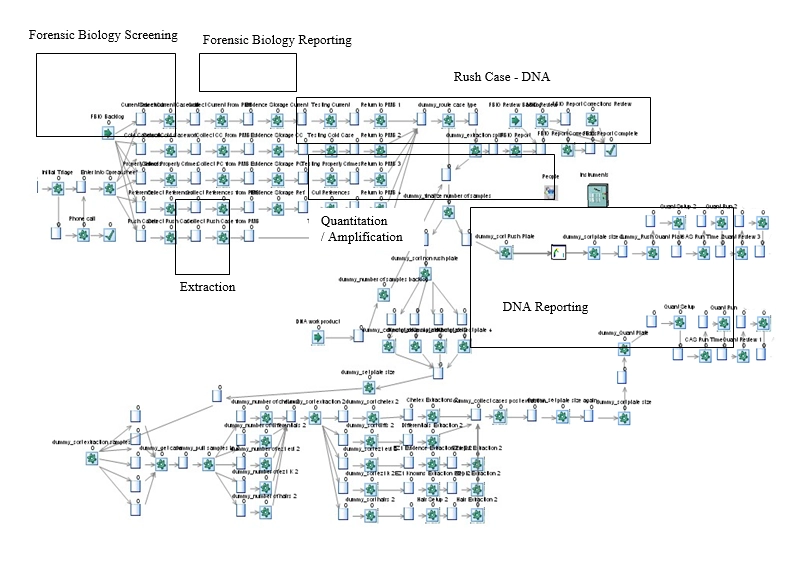Denver Police Department Crime Laboratory improves turnaround times

- Industry
- Pharma & medtech
- Location
- Denver, Colorado, U.S.
- Project goals
- Identify optimum areas for investment to improve turnaround times
Achievements with Simul8
-
-
Risk-free testing of ideas to tune the system to optimal performance
-
-
Discovered additional staffing would enable the lab to meet targets
-
-
Avoided costly investment in equipment that would not solve the problem
About the project
Faced with tighter funding and increased demand, many forensic laboratories are examining their processes to do more with their resources. DNA Units in particular have experienced a sharp rise in demand in recent years as a result of the growing use of DNA testing as an investigative tool.
Between 2001 and 2011, the DNA Unit of the Denver Police Department (DPD) Crime Laboratory saw a 228% increase in its caseload. Despite expanding the laboratory to improve capacity, the volume of cases submitted for DNA testing continued to lead to longer turnaround times (the time taken from when a lab request is a received until the results are reported).
With a growing backlog of work, identifying potential improvements became a challenge with limited flexibility to assess operational changes that could help to further increase capacity.
To overcome this challenge, the DPD Crime Laboratory turned to Simul8 simulation software to thoroughly evaluate two potential investment options for improving efficiency; purchasing additional equipment and hiring more staff.

How was Simul8 used to assess efficiency improvements?
When analyzing approaches for improving DNA efficiencies, the DPD Crime Laboratory was challenged by the fact that it only had a subjective view of its processes, as well as limited data to assess solutions to improve efficiency. As a result, Simul8 simulation software was chosen as a solution to provide a more objective, evidence-based approach.
The DPD Crime Laboratory learned of Simul8 via the Denver District Attorney’s Office, who had achieved success in simulating the Denver County Court system which handles over 20,000 cases each year. The simulation highlighted bottlenecks in the system and was also used to test solutions for improving the efficiency of resources and staff.
Using Simul8 for the first time, the DPD Crime Laboratory were quickly able to develop a simulation capturing the entire flow of DNA laboratory processes. This was created in conjunction with the personnel working in the DNA unit to help ensure that all steps in the laboratory processes were captured within the simulation. To further validate the simulation, one year of real casework data was entered and ran through the simulation to compare the results and verify its accuracy.
From there, the Improvement Project Manager could use the simulation to make changes to the existing laboratory process and evaluate the impact of adding additional equipment and staffing on overall efficiency and turnaround times.
What was the impact of additional laboratory equipment?
Within the simulation, the Improvement Project Manager could easily test changes to laboratory equipment levels. For example, doubling the DNA Extraction robot quantity from two to four.
The simulation provided interesting results: when more instruments were added, such as the additional DNA extraction robots, work still waited and the DNA backlog did not improve. Why was this the case?
The simulation showed that none of the instruments were being utilized at full capacity, meaning they were idle for significant time periods and many areas were ‘resource starved’. That is, they were waiting for an analyst to become available to complete the task.
With the results showing that the current levels of equipment were not a constraint on the system, the simulation could then be used to identify whether additional staff would help alleviate case backlog and turnaround times.
What was the impact of hiring more staff?
Using the simulation, the Improvement Project Manager could then assess the DNA Unit staffing that would be required to meet its target case turnaround time.
By running trials with different levels of staffing in Simul8, the results showed that the ideal number of staff for the DNA Unit’s current caseload levels would be 14 fully trained analysts, accompanied by three lab technicians, three supervisors and one staff assistant.
To help understand the long-term impact and ROI of additional these analysts, the simulation run time was extended to three years. Using this approach, it was shown that four new analysts would provide the optimum return. The simulation also demonstrated that although hiring more than four analysts would drastically reduce the current backlog, by the second year the analysts’ utilization levels would drop to under 20% - making this investment inefficient in the long run.
The simulation revealed that when the DNA Unit reached optimum staffing levels with all staff fully trained, it would take six months to eliminate the existing backlog. After new staff are fully trained, this would enable the DNA Unit to achieve its target turnaround times of seven days for rush cases and 45 days for all other case types.
A fast, evidence-based approach for assessing laboratory investment
Before using Simul8, the DPD Crime Laboratory had limited evidence and a subjective view of how to improve its processes. By simulating the DNA Unit workflow, they were able to identify areas for improvement, test new ideas, and understand how to tune the system to optimal performance - all in a risk-free environment.
Simulation has helped to DNA Unit to present an evidence-based, compelling case to upper management that additional staffing resource would enable the laboratory meet turnaround targets, while also avoiding costly investment in equipment that would not solve the problem.
Learn more about Simul8 for pharmaceutical and medtech process improvement
Find out more about how simulation is used by organizations, read more case studies and access a range of learning resources.
Learn more